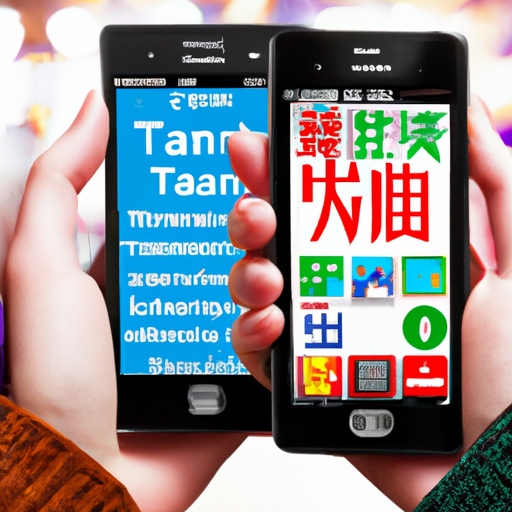
What Are The Options For Language Translation Apps Or Devices?
If you’ve ever found yourself in a foreign country, struggling to communicate with the locals and navigate through different languages, you’re not alone. Language barriers can be a real challenge, but luckily, there are options available to bridge that gap. Whether you’re a frequent traveler, an international businessperson, or simply someone who loves exploring new cultures, language translation apps or devices can be invaluable tools. In this article, we’ll explore the various options out there, helping you make an informed decision when it comes to breaking down language barriers.
Option 1: Mobile Language Translation Apps
Features of mobile language translation apps
Mobile language translation apps have become increasingly popular in recent years, offering users a convenient and portable way to communicate in different languages. These apps typically provide a range of features to facilitate translation, including text translation, voice translation, and even image translation. With text translation, users can simply type or paste the text they need to translate, and the app will provide an instant translation. Voice translation allows users to speak into their device and have their words translated in real-time, making it particularly useful for conversations. Some apps also offer image translation, where users can take a photo of text in another language and have it translated. Additionally, many mobile language translation apps offer offline capabilities, allowing users to translate without an internet connection.
Pros and cons of mobile language translation apps
One of the biggest advantages of mobile language translation apps is their convenience. These apps can be easily accessed on smartphones or tablets, making them highly portable and accessible anytime, anywhere. They provide a quick and efficient way to communicate with people who speak different languages, whether you’re traveling, conducting business, or simply trying to overcome language barriers in your daily life. Mobile language translation apps also offer a wide range of language options, allowing users to translate between numerous languages.
However, there are a few potential drawbacks to consider. Mobile language translation apps rely on internet connectivity, so if you’re in an area with poor signal or no access to the internet, their functionality may be limited. Additionally, while these apps have made significant advancements in accuracy, machine translation still has its limitations. The translations provided by these apps may not always be completely accurate, especially for complex sentences or idiomatic expressions. Cultural nuances and context can also impact the accuracy of translations. Therefore, it’s important to use these apps as a helpful tool rather than relying solely on them for precise translations.
Examples of popular mobile language translation apps
There are numerous mobile language translation apps available in the market today, each with its own unique features and capabilities. Some of the most popular apps include Google Translate, Microsoft Translator, and iTranslate. These apps offer extensive language support, offline translation capabilities, and user-friendly interfaces. They have received positive reviews from millions of users worldwide and continue to be widely used as reliable translation tools.
Option 2: Online Language Translation Platforms
Features of online language translation platforms
Online language translation platforms offer a web-based solution for users to access translation services without the need for downloading or installing specific apps on their devices. These platforms typically provide similar features to mobile language translation apps, including text translation, voice translation, and image translation. Users can visit the platform’s website, input their desired text or use voice input, and receive instant translations. Online language translation platforms also often include additional features such as language dictionaries, phrasebooks, and language learning resources, providing users with a comprehensive language support system.
Pros and cons of online language translation platforms
One of the key advantages of online language translation platforms is their accessibility. Users can access these platforms through any web browser, regardless of the device they are using, be it a desktop computer, laptop, or smartphone. This makes online platforms a flexible option for those who don’t want to clutter their device with multiple apps or prefer a browser-based interface. Online platforms also typically offer a wide range of language options, allowing users to translate between numerous languages.
However, similar to mobile language translation apps, online platforms also rely on internet connectivity for their functionality. If you’re in an area with poor signal or no access to the internet, you may experience limitations in using these platforms. Additionally, the translation accuracy of online platforms can vary depending on the specific platform and the complexity of the text being translated. Cultural nuances and context can also pose challenges to achieving completely accurate translations. As with any machine translation tool, it is important to use online language translation platforms as a helpful aid rather than relying solely on them for precise translations.
Examples of popular online language translation platforms
Several online language translation platforms have gained recognition and popularity for their reliable translation services. One notable example is DeepL Translator, which utilizes artificial intelligence and neural networks to provide highly accurate translations. Another popular platform is Babylon Translator, known for its extensive language support and comprehensive language resources. Google Translate also offers an online platform version, providing users with the convenience of accessing its translation services through a web browser. These platforms have built a strong reputation for their translation capabilities and are widely used by individuals and businesses alike.
Option 3: Dedicated Language Translation Devices
Features of dedicated language translation devices
Dedicated language translation devices are standalone devices that are specifically designed for language translation purposes. These devices typically offer a wide range of features to assist users in overcoming language barriers, such as text translation, voice translation, and even offline capabilities. Unlike mobile apps or online platforms, dedicated devices are purpose-built for translation, providing a more specialized and focused experience. They often have larger screens or displays, making it easier to read and understand translations, and may offer additional features like language dictionaries, phrasebooks, or cultural guides.
Pros and cons of dedicated language translation devices
One of the major advantages of dedicated language translation devices is their dedicated focus on translation functionality. These devices are designed specifically for language translation, resulting in a streamlined and efficient user experience. They often boast highly accurate translation capabilities, thanks to advanced technologies and algorithms. Dedicated devices also typically have longer battery life and may offer extended offline capabilities, allowing users to rely on them even in areas with limited internet access.
However, dedicated language translation devices may be less versatile compared to mobile apps or online platforms. While they excel in translation functionality, they may lack the extensive features or resources available on other platforms. Additionally, dedicated devices often come with a higher price tag compared to mobile apps or online platforms, making them a less affordable option for some users. It’s also worth noting that their physical design and bulkier form factor may make them less portable compared to smartphones or tablets.
Examples of popular dedicated language translation devices
Some dedicated language translation devices that have gained popularity in recent years include the Pocketalk Translator and the ili Instant Offline Translator. The Pocketalk Translator offers a sleek design and supports translation between 74 languages, with offline translation capabilities available in several languages. The ili Instant Offline Translator, on the other hand, focuses on offline functionality and can provide immediate translations without the need for an internet connection. These devices have received positive reviews for their accuracy and ease of use, making them popular choices for travelers and individuals seeking a dedicated translation device.
The article continues with several more options for language translation apps or devices, including voice-activated language translation devices, wearable language translation devices, offline language translation apps, browser extension translation tools, language translation earbuds, language translation smartpens, and integrating language translation software into existing devices.







